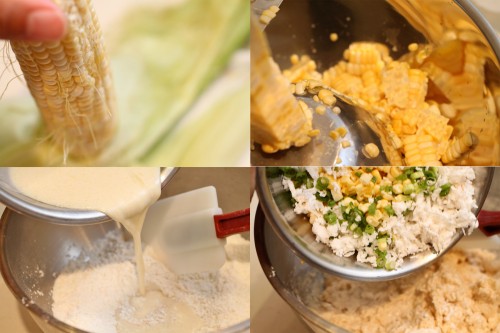Smoky Spicy Corn Pudding
Seriously. I had a somewhat interesting story for how I came up with this recipe, but I keep going to the fridge and sticking a fresh spoon into this now cold, smoky, spicy corn pudding and taking a bite. Then, tossing the spoon into the sink to prevent a second bite. I’m hedging because I don’t want to admittedly portion a piece out, heat it up and eat it (after the three helpings I had last night), but I seriously can’t help myself. It is that tasty…even cold and semi-solid in the fridge.
Growing up in Florida (yes, it’s still the South!), I developed such a weakness for southern food, and corn pudding, itself, is classic, southern comfort food at its best. And I know I did some corn fritters not too long ago and repeating corn might be a sin, but it’s such a seasonal staple in my house. and this is just too good not to share.
There are tons of variations and no real right way to make corn pudding, but I prefer this method because it stays creamy, sweet, with a caramelized top, and it still cuts easily without being bread-like. I mention the combo of mustard seeds and curry leaves in a previous post, and this marries incredibly well with the spiciness from the peppers, the sweet tang of the sundried tomatoes, and the deep, lovely smokiness from the mozzarella. I wanted smokiness without bacon-y flavor (for once), and the result here is divine. I’m likely making this for Thanksgiving this year, which is always a cultural trip! Enjoy!
Ingredients
Yields 1 2-quart baking dish
4 to 6 medium ears of corn (you want 3 ½ cups of the kernels), husks and silk removed
olive oil
salt & pepper
1 tbsp canola or vegetable oil
2 tbsps butter
1 ½ tbsps brown mustard seeds
10 curry leaves
2 shallots, finely chopped
1 red cherry, fresno or jalapeno pepper, minced (seeded and ribbed only if you can’t take the heat!)
3 garlic cloves, minced
1 tbsp finely chopped sundried tomatoes (either packed in oil or rehydrated)
¼ cup all-purpose flour
3 eggs
2 cups heavy cream
a couple dashes of Tabasco
1 ¼ tsp salt
½ tsp black pepper
1 ¼ cups grated smoked mozzarella
¼ cup sliced green onions, dark and light green parts only
Procedure
The first step of this dish is roasting or grilling the corn. Brush the corn with olive oil and season with salt and pepper. Place cobs on a hot grill or a grill pan and cook for 20 minutes, rotating every few minutes to cook all sides. If you don’t have a grill, you can place the seasoned corn on a baking sheet under the broiler for the same amount of time (still rotating). Let cool slightly, cut the kernels from the cobs, and reserve kernels in a separate bowl.
Preheat the oven to 350° F.
In a medium skillet, heat oil and butter on medium-high heat. Once foam subsides, add mustard seeds and curry leaves. Once the seeds start to sputter and pop, lower the heat to medium-low and add shallots, peppers and a pinch of salt. Cook for a few minutes until shallots are translucent. Add garlic and cook 30 seconds until fragrant. Add sundried tomatoes, corn kernels, and flour and stir to coat. Cook for another 30 seconds, stirring. Remove from heat and transfer to a large bowl.
In a separate bowl, beat together eggs, cream, Tabasco, salt, and pepper. Add this along with the grated smoked mozzarella and the green onions to the corn mixture and combine thoroughly. Transfer to a greased 2-quart baking dish and bake for 50 minutes or until an inserted knife comes out clean.
Let cool slightly before serving.






























